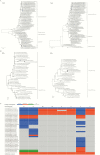Evidence for Cross-species Influenza A Virus Transmission Within Swine Farms, China: A One Health, Prospective Cohort Study
- PMID: 29401271
- PMCID: PMC5848305
- DOI: 10.1093/cid/cix823
Evidence for Cross-species Influenza A Virus Transmission Within Swine Farms, China: A One Health, Prospective Cohort Study
Abstract
Background: Our understanding of influenza A virus transmission between humans and pigs is limited.
Methods: Beginning in 2015, we used a One Health approach and serial sampling to prospectively study 299 swine workers and 100 controls, their 9000 pigs, and 6 pig farm environments in China for influenza A viruses (IAVs) using molecular, culture, and immunological techniques. Study participants were closely monitored for influenza-like illness (ILI) events.
Results: Upon enrollment, swine workers had higher serum neutralizing antibody titers against swine H1N1 and higher nasal wash total immunoglobulin A (IgA) and specific IgA titers against swine H1N1 and H3N2 viruses. Over a period of 12 months, IAVs were detected by quantitative reverse-transcription polymerase chain reaction in 46 of 396 (11.6%) environmental swabs, 235 of 3300 (7.1%) pig oral secretion, 23 of 396 (5.8%) water, 20 of 396 (5.1%) aerosol, and 19 of 396 (4.8%) fecal-slurry specimens. Five of 32 (15.6%) participants with ILI events had nasopharyngeal swab specimens that were positive for IAV, and 17 (53.1%) demonstrated 4-fold rises in neutralization titers against a swine virus. Reassorted Eurasian avian-lineage H1N1, A(H1N1)pdm09-like, and swine-lineage H3N2 viruses were identified in pig farms. The A(H1N1)pdm09-like H1N1 viruses identified in swine were nearly genetically identical to the human H1N1 viruses isolated from the participants with ILI.
Conclusions: There was considerable evidence of A(H1N1)pdm09-like, swine-lineage H1N1, and swine-lineage H3N2 viruses circulating, likely reassorting, and likely crossing species within the pig farms. These data suggest that stronger surveillance for novel influenza virus emergence within swine farms is imperative.
Keywords: China; One Health; emerging pathogens; influenza A virus; swine.
© The Author(s) 2017. Published by Oxford University Press for the Infectious Diseases Society of America. All rights reserved. For permissions, e-mail: journals.permissions@oup.com.
Figures



References
-
- Shortridge KF, Webster RG, Butterfield WK, Campbell CH. Persistence of Hong Kong influenza virus variants in pigs. Science 1977; 196:1454–5. - PubMed
-
- Zhou N, He S, Zhang T et al. . Influenza infection in humans and pigs in southeastern China. Arch Virol 1996; 141:649–61. - PubMed
-
- Shortridge KF. Pandemic influenza: a zoonosis?Semin Respir Infect 1992; 7:11–25. - PubMed
Publication types
MeSH terms
Substances
Grants and funding
LinkOut - more resources
Full Text Sources
Other Literature Sources
Medical
Miscellaneous

